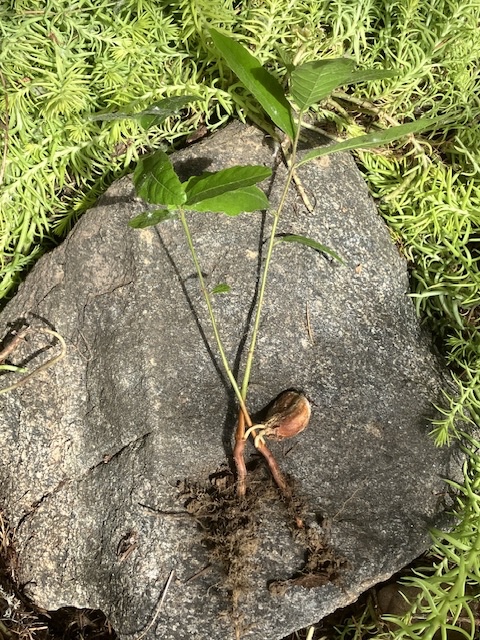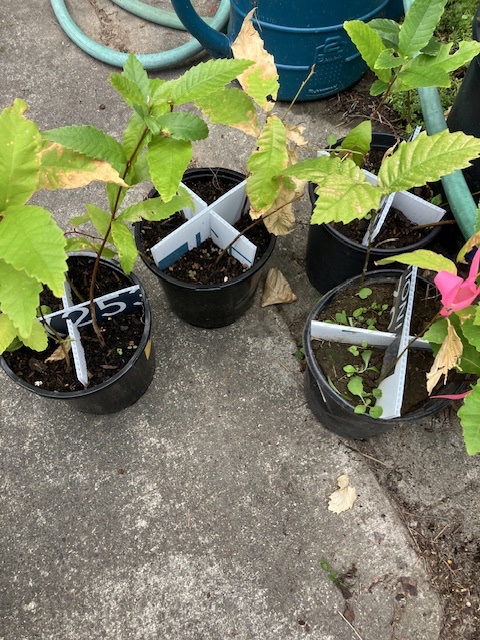Last June 2022, at their annual sidewalk sale, One Green World was giving away Colossal Chestnut seedlings with yellowed leaves, in desperate need of some tlc. I took six home and repotted them immediately; within a short time, they all greened up and looked great. I planted them a couple of weeks ago, and they're just now starting to break dormancy.
Colossal chestnuts produce sterile pollen and require other chestnut trees in order to make nuts. Since these are seedlings, however, they're half Colossal and half something else. Is is reasonable then to assume that these seedlings may/will produce viable pollen? It would be preferable to not buy two chestnuts; but I also don't want to wait 5 or 10 years before finding out that yes, indeed, two additional chestnut varieties should have been planted. If there's a decent chance that their pollen will be good, then I'm willing to take the gamble.
GH said
Colossal chestnuts produce sterile pollen and require other chestnut trees in order to make nuts.
I wonder if some chestnuts are unable to freely produce pollen due to the unpredictable nature of some chestnuts being hybrids due to them being interspecific crosses. For example hybrid sterility shows up in prunus when crossing geographically isolated parents in their own lack of ability to release pollen or the pollen can be released and weak or sterile as you say.
These problems in prunus (at least in cherries plums) owe either to one or the other or both, meaning that it seems more likely to be a male only problem but could be also male and female inter-incompatability. To define what this type of infertility means I stole this from the internet;
"What is gametic incompatibility?
Gametic incompatibility is one of the mechanisms of reproductive isolation. It is based on species-specific molecular interactions that prevent heterospecific fertilization. Although gametic incompatibility may occur in any sexually reproducing organism, it has been studied only in a few model species."
/quote/unquote
Species such as sorbus (mountain ash) and even malus (apple) don't have much if any of these barriers the way cherry and plum types do. I'm not sure about chestnuts because I have not paid so much attention over the years in what breeders have tried to accomplish (ie. between american and european chestnuts) enough to know for sure what's required because sometimes these barriers exist for two or three generations as may be the case of Colossal chestnuts.
Both issues in plums though, are mostly remedied by the planned crossing, the interspecific plum as the mother, and "only" when the male pollinator is the same pure species of one of the mother's parents. "" I highlighted that word because there have been sufficient studies that discuss this principle out there. The most recently regarding plums by Rick Sawatsky of Saskatchewan who is now retired from breeding plum and cherries.
If you were to research this out yourself with the recommendation about plums and follow that with findings of what (if any) can be traced to parental species of Colossal chestnut then if it were me I would plant one of the parents as a pure breed only species. There's also a good chance the female parent is likely to be more pollen compatible choice as a "pollen compatible" because of reports of grafting problems that have proven out that may have some degree of accuracy over time. I have seen experts recommend species of chestnuts as the "more better" rootstock for hybrid chestnuts but that doesn't necessarily mean that as a pure species is reliable unless Colossal is part of that species, which it probably isn't because Mike Dolan recommeded using a species different than american or european chestnut which might be what Colossal consists of.
Thanks for the input.
One Green World's description of Colossal states that it's a Japanese/European hybrid. Who knows what the pollen parent contributes.
From OGW's website:
Pollination Requirements: Plant at least two trees for nut production.
It's a good bet, then, that additional Chestnut trees won't be needed. Although they're supposed to have good disease resistance, Colossal doesn't seem to be a favorite chestnut for eating. Since they were planted mostly for wildlife, though, that's not a concern.
I appreciate that OGW chose to give the trees away, instead of disposing of them. The normal price per tree is $21.95, so that was a $131.70 savings. If even two of the six trees survive, I'll be happy.
Thanks to squirrels, I also planted three volunteer nut trees. I don't know what type of nut (maybe walnut?), but they should make lovely trees even if there isn't nut production. It's fun to find volunteer trees and costs nothing but the time it takes to transplant them.
I was doing some sprucing up of my flower beds and found several chestnut seedlings. I thought it unusual that there are several double seedlings from one nut. I wonder what causes that or if it’s very common. Seems like at least 1/3 were double seedlings.

Dubyadee, did you plant the trees? Were the doubles easily divided? Since no one responded to your post, it's probably not such a common occurrence.
Since our weather seems to be getting hotter and dryer, will these volunteer trees be able to thrive without supplemental watering after a few years? Struggling through a few summers is manageable, but lugging buckets of water after that is not a pleasant thought.
 I searched the internet for information about multiple seedlings and found this occurs in mangoes quite frequently. The term is “polyembryonic seed”. The information stated there can be three different embryos in the nut with two being pollinated crosses and one being a clone of the parent tree. The seedlings are easily separated, they have an “umbilical stem” to the nut that you snip and then the tap roots separate easily. I transplanted several directly into the ground and will water this year. The tap root helps the tree survive dry conditions to some degree. I had found seedlings around the yard last summer that I tied ribbons around to help me find them this spring when I wanted to transplant them. Several were dead this spring because of our extended drought season in 2022, I had not watered them at all. We didn’t have significant rains until late October last year, normally early September we get rain and I expect the survival rate would have been better. I even found seedlings in my bark dust pile that grew well until September.
I searched the internet for information about multiple seedlings and found this occurs in mangoes quite frequently. The term is “polyembryonic seed”. The information stated there can be three different embryos in the nut with two being pollinated crosses and one being a clone of the parent tree. The seedlings are easily separated, they have an “umbilical stem” to the nut that you snip and then the tap roots separate easily. I transplanted several directly into the ground and will water this year. The tap root helps the tree survive dry conditions to some degree. I had found seedlings around the yard last summer that I tied ribbons around to help me find them this spring when I wanted to transplant them. Several were dead this spring because of our extended drought season in 2022, I had not watered them at all. We didn’t have significant rains until late October last year, normally early September we get rain and I expect the survival rate would have been better. I even found seedlings in my bark dust pile that grew well until September.
If unable to water them all summer I would suggest any transplanting be done in February or March to give them more time to recover and take root before our dry season begins. I clipped the nut off the transplants so squirrels would not damage them by digging up the remaining nut, not sure if that was necessary but it seems to weaken the young plant as it could be getting nutrients from the nut. I also potted up some seedlings in gallon pots that I divided into quarters so I can water them through the summer and plant this fall.
Idyllwild
jafar
Marsha H
Viron
John S
1 Guest(s)
